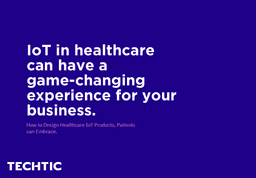How to Design an End-to-End Healthcare IoT Platform?
Sector: Digital Product, Future Tech, UI/UX
Author: Hemant Kumar
Date Published: 11/04/2019

Contents
Designing a healthcare product comes with a lot of responsibilities, as it involves the critical well-being of people involved. Advancement in technology and advent of emerging tech like Internet of Things (IoT) have changed the way healthcare solutions are perceived and built.
In fact, building an IoT product for Healthcare can be really tricky since it calls for heightened involvement and expertise to actually use the right data so as to build the most apt ‘connected healthcare’ solution.
Techtic Solutions has been in the forefront when it comes to building breakthrough healthcare product by implementing the Internet of Things. In this article, we will also discuss how Techtic created a solution for Alzheimer’s patients using IoT.
Start with Building IoT the Right Way
IoT along with AI (artificial intelligence) has been creating a sizeable impact in the way digital transformation is embraced in the healthcare industry. From patient management in hospitals and beyond to driving preventative care, the implementation of IoT will help healthcare providers to monitor their patient’s health remotely using sensors and support tools.
In one of our client projects on healthcare IoT with a firm from Atlanta, IoT experts at Techtic ushered their experience of designing a viable Healthcare IoT product. It was built end-to-end by the in-house team by following the right steps from creating a design sprint for solving the right problem to finally building a solution that can be installed into senior care facilities across the country.
The Problem to Solve and How Techtic Did it Right
The team of expert developers working on this ambitious project at Techtic took up the challenge to solve a problem for the senior facilities. It was to identify the analytics of each senior’s and build a pattern to monitor their health conditions using just the data. The product would help take care of senior’s regular life analytics like walk, sleep, breaks, sitting, and other daily cycles.
The team could solve the problem using the right number of sensors and those sensors facilitated giving out enormous information on the day-to-day routine of each senior. This information was harnessed to build an IoT product that would help the senior care facility monitor conditions of each person in its care.
Roadmaps to IoT Product Designing for Successful Execution

IoT in healthcare can have a game-changing experience for your business. It is not only about creating a product that can uplift and revolutionize the critical aspect of the industry requirement, but also in relation to creating a solution that can make a substantial difference to the community service.
Designing for IoT in healthcare however is best executed by following certain process roadmaps to design, while building incredible, extensively usable and highly regarded IoT solutions. Here is a snapshot:
1. Understand Pain Points (Patients and/or Facilities)
Communicating is the best way to find the solution to a problem, and this literally stands right in the healthcare industry. Interviewing the facilities and patients with certain conditions can help identify the pain areas and help derive seamless IoT solution with minimal or no human efforts.
2. Improvisation is the Key - Be Ready
Building a full-fledged IoT healthcare solution may not invite the best result. So, invest your time and money in building a healthcare MVP first, evaluate user opinion with real-world data samples for the product and go ahead with building the final product with a better experience.
3. Minimal or No Human Efforts Required
Considering healthcare by itself is an intense process that requires high engagement from caregivers, focus on designing a solution that is minimalistic in terms of human efforts. Make it effortless by building a solution that becomes more automated with the input of less data from the user, and thereby become more usable and friendly.
Now, to achieve this you need to design IoT Healthcare products that are sensor-driven, and also make sure that the right combination of sensors is implemented so as to achieve the right kind of case. For instance, if the patient is sleeping in a room, this means, the pressure mat on the bed shows the pressure on the bed, while at the same time, the light sensor will indicate no or minimal lights in the room (as there is no motion). Such an instance would be a case where we can say patient is asleep.
Over to you…
IoT is one of the most anticipated sectors to digitize the Healthcare sector. From automatically integrating devices with your digital patient records to giving healthcare providers real-time and readily accessible data to make better decisions, Internet of Things is changing the face of Healthcare economy.
Are you contemplating building IoT solutions for the healthcare industry? This can be the right time as the industry implementations are at a nascent stage and a first mover advantage can work wonders for the Healthcare sector as well as your business.
If you have an idea to realize or wish to take your current IoT product to the next level, get in touch with our team of expert IoT developers at Techtic Solutions. From getting on with the design sprint to having your product developed, we can guide you through the entire process for successful execution of the project.
Latest Tech Insights!
Join our newsletter for the latest updates, tips, and trends.







